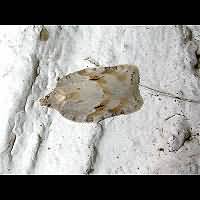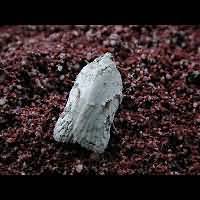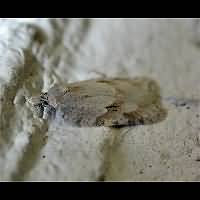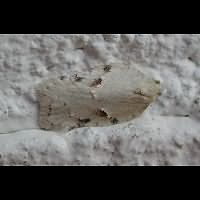Acleris logiana, a Tortrix Moth
Acleris logiana is a beautiful, white Tortrix Moth. It apparently does not have a common name in English. There are some other species looking a lot like this one. Identification however is not particularly difficult if you look at the combination of the particulars given below. First of all the colour of the upperwings is a milky white. In the middle of the wing, at the top edge, is a dark half circle. Sometimes it is well developed and clearly visible. Other times it is just hinted by some smears. But it is always there and it is always an open half cicrle, while in many look-a-like species this circle is filled up by darker scales. Near the circle run one or two more or less wavy, broad lines over the wings. These two may be very pronounced, but at times are hardly visible rows of smears. The lines are usually of a lighter colour than the circle. The colour of this circle and these lines is highly variable: brownish, reddish or yellowish. Acleris logiana has a typical resting pose: flat to the surface it sits on, with neither legs nor antennae visible. It gives the impression of a very small Owlet Moth. The species' wingspan is some 18 to 22 mm.
In spring the eggs are deposited on the leaves of birch trees. The young caterpillars spin two or three leaves together and lives inside. They rather quickly pupate to reveal fresh new adult moths in June and July. These are going to live for a long time, for it is the adult overwintering. Often the adults are not very active: they will be found at the same resting place (often the trunk of a birch) for many days in a row, especially in autumn and winter. The caterpillar of this species is found on one hostplant only: the birch.
This species can be seen for a very long time indeed: adults regularly appear all year round, except for the two coldest winter months. However it never appears in great numbers. This white Tortrix is hardly ever attracted to light. In Britain this has been a species of the Scottish Highlands only for a very long time, but nowadays it regularly turns up southwards. But it is still a rare species in England and Wales. In the Benelux this species is quite common where ever the host plants are present. Also a common species in Northern Europe and Western Siberia.
Acleris logiana is a beautiful, white Tortrix Moth. It apparently does not have a common name in English. There are some other species looking a lot like this one. Identification however is not particularly difficult if you look at the combination of the particulars given below. First of all the colour of the upperwings is a milky white. In the middle of the wing, at the top edge, is a dark half circle. Sometimes it is well developed and clearly visible. Other times it is just hinted by some smears. But it is always there and it is always an open half cicrle, while in many look-a-like species this circle is filled up by darker scales. Near the circle run one or two more or less wavy, broad lines over the wings. These two may be very pronounced, but at times are hardly visible rows of smears. The lines are usually of a lighter colour than the circle. The colour of this circle and these lines is highly variable: brownish, reddish or yellowish. Acleris logiana has a typical resting pose: flat to the surface it sits on, with neither legs nor antennae visible. It gives the impression of a very small Owlet Moth. The species' wingspan is some 18 to 22 mm.
In spring the eggs are deposited on the leaves of birch trees. The young caterpillars spin two or three leaves together and lives inside. They rather quickly pupate to reveal fresh new adult moths in June and July. These are going to live for a long time, for it is the adult overwintering. Often the adults are not very active: they will be found at the same resting place (often the trunk of a birch) for many days in a row, especially in autumn and winter. The caterpillar of this species is found on one hostplant only: the birch.
This species can be seen for a very long time indeed: adults regularly appear all year round, except for the two coldest winter months. However it never appears in great numbers. This white Tortrix is hardly ever attracted to light. In Britain this has been a species of the Scottish Highlands only for a very long time, but nowadays it regularly turns up southwards. But it is still a rare species in England and Wales. In the Benelux this species is quite common where ever the host plants are present. Also a common species in Northern Europe and Western Siberia.







